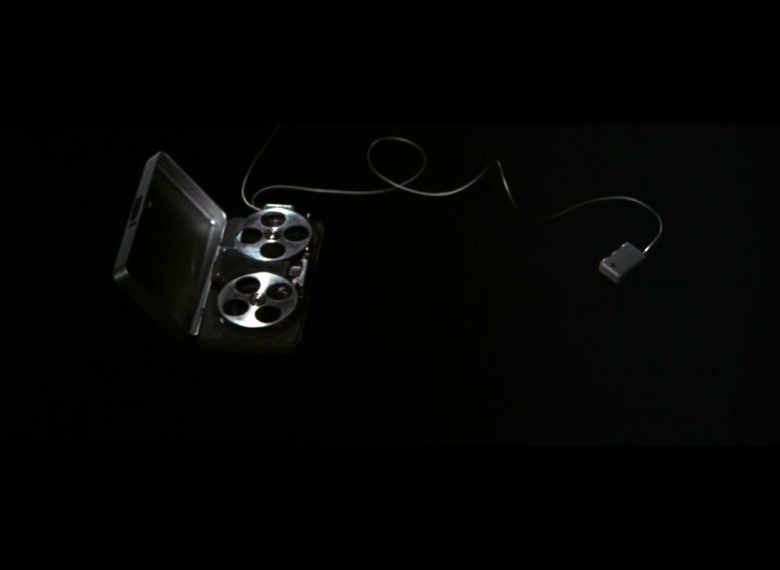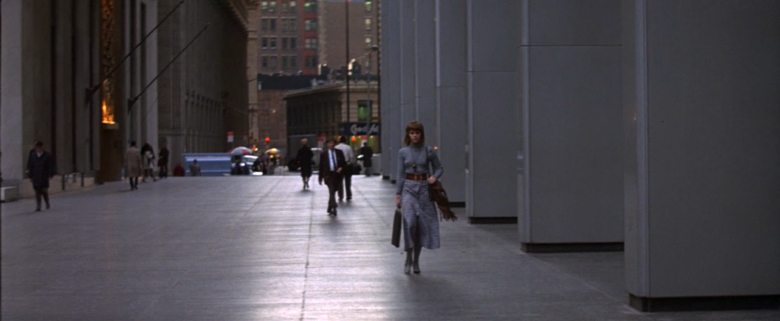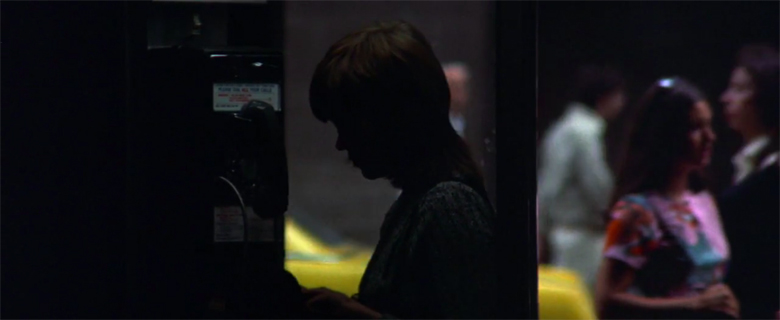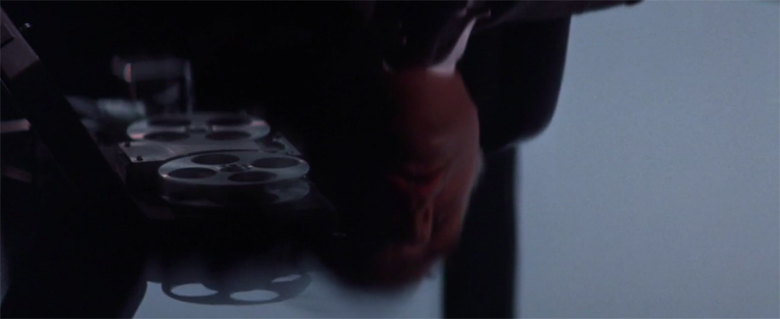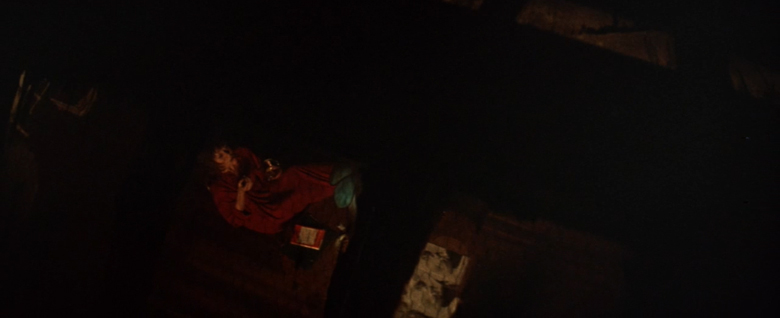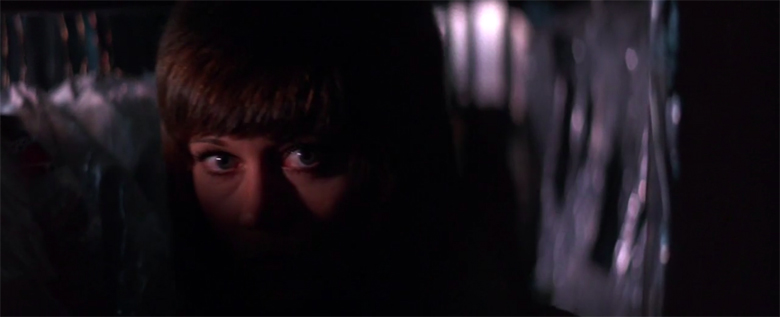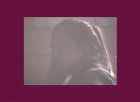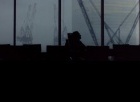Mid-afternoon. A young woman in a grey turtleneck and maxi-skirt walks alone in New York. It’s a long-shot; she ambles down a shiny skyscraper entranceway, and darts into a glass telephone booth to place a phone call. Her face and figure are silhouetted against the window, taxis drive in the background, shadows walk in and out of the shot. As she inserts money into the payphone, a male voiceover says, “…A good call girl, she’ll turn six or seven hundred tricks a year—faces get blurred. And since then, she’s reported several instances like breather calls, anonymous phone calls. Also, somebody may be following her, watching her... things like that.”
Oblivious to the male voice talking about her, Bree Daniels (Jane Fonda) continues to dial on the rotary phone. The male voiceover, positioned over a contemplative and anonymous gaze on Bree, establishes a voyeuristic and—more importantly, gendered—gaze that lingers throughout the length of the film. As the men discuss Bree sonically, the cinematography approaches her like one such man: watching, following, and stalking her. Bree senses someone watching, she’s afraid of the dark, she thinks someone’s been prying her mailbox open, but she distrusts her own intuition, saying, “It’s just nerves—I’m a nervous broad, it doesn’t mean anything.” Fragments of fear orchestrate the bubbling sensation of paranoia Alan Pakula’s Klute (1971) thrives on.
The first film of Pakula’s aptly named “paranoia trilogy,” followed by The Parallax View (1941) and All the President’s Men (1976), Klute is screening on February 15th as part of the Calgary Cinematheque’s Masters: Wexler and Willis series. Peter Cable (Charles Cioffi) hires family friend, Detective John Klute (Donald Sutherland), to find a missing colleague, Tom Gruneman (Robert Milli). Detective Klute soon falls into the world of vice and violence, tracking down call-girl Bree Daniels, who was one of the last to be in contact with Gruneman before his disappearance. Various call-girls associated with Gruneman begin to turn up dead, and Klute fears for Bree’s safety as they engage in a romantic relationship.
Explicit point-of-view (POV) shots are used throughout Klute. For example, twice in the film, the handheld camera looks down through Bree’s skylight, spying on her, oblivious, inside her apartment. Later, the stalker gazes predatorily into Bree’s kitchen window, this time through the added visual blockage of a chain link fence. The viewer stares through the stalker’s eyes at Bree, fingers gripping the cold metal links. In most of these sequences, a sinister non-diegetic score overlays a realistic sound perspective from where the stalker (and camera), are spatially situated. These shots, peppered throughout the film, make the audience explicitly aware that they are seeing through the killer’s eyes.
In film critic Roger Ebert’s original review, he criticized Klute for including numerous POV shots from the killer’s perspective. He wrote, “The threat should always be seen from the point of view of the threatened. We don't like looking over the killer's shoulder at his victim; shots like that interfere with our desire to identify with the victim and be scared in a satisfactory way.”1I, on the other hand, would argue that Pakula’s POV strategy was both intentional and important, repeated throughout the film. It provides point-of-view imagery where no known character could logically be watching Bree, and thus transforming the audience into a voyeur. Throughout the film, Pakula intentionally uses specific cinematic techniques to suggest this.
As in the previously mentioned payphone scene, Bree is often filmed in a long shot walking alone. While one single shot of Bree walking alone would not be notable, it is the combined use of a shaky handheld camera, its specific way of tracking her movements, and an unnerving score that connotes feelings of voyeurism. These shots, even without indicating the hands or movements of the stalker in question, formally and repeatedly resemble the killer’s POV shots, implicating the viewer and technology itself just as much as the stalker.
Midway into the film, Bree enters a nightclub. The audience watches her enter from across the dance floor. As dancers cross in front of the camera, it becomes apparent that the scene is filmed as if we, the viewer, were occupying a position on the dance floor, our attention transfixed on Bree—just like the stalker. The diegetic music playing within the club utilizes a high degree of sound perspective; we see Bree talking, but, due to the camera being positioned far away and the loud music, no words are heard. Eventually, Bree makes her way across the club, towards the camera, stopping once she sees that her pimp, Frank (Roy Scheider), has been watching her. However, his POV does not align with the camera. Bree stares off-screen at him, and he meets her gaze with a cold glare. Like a ghost, the camera lingers, observing Bree’s face. We can stare, with the same lingering looks that the stalker does, but with none of the repercussions.
Like the sequence in the club, the camera, and thus the viewer, is transformed into a voyeuristic specter.
Later, after finding her apartment ransacked, Bree leaves, anxiously looking to see if anyone is watching her. Unbeknownst to her, the camera’s eye watches through a chain link fence. It pans, following her movements, while again replicating an authentic sound perspective of traffic and children playing. Suddenly, the now familiar, siren-like score interrupts the serene diegetic sounds and we zoom out, revealing the viewpoint to be located in the back seat of a car, occupied by the stalker, who abruptly exits the car to follow Bree. The film immediately cuts with this sudden movement, and the camera tracks left to follow Bree. At first, we assume that this is another handheld POV shot as it is filmed, like the preceding shot, through the chain link fence. However, this illusion is quickly shattered. A few moments after Bree passes a hearse, the camera abruptly cuts again, showing the stalker standing beside the vehicle, watching and following Bree. Notably, this shot is also filmed through the chain link fence and at approximately the same angle as the previous two shots. The presupposed POV is shattered. No longer does the camera occupy a diegetic role within the film’s narrative. Like the sequence in the club, the camera, and thus the viewer, is transformed into a voyeuristic specter. We become an individual on the street, spying on the stalker and his target.
Notably, Bree, not the titular Klute, is featured most prominently in the film. We see her in personal, private moments—talking to her therapist, alone in her tiny apartment, walking the streets of New York, and meetings with clients. In brief moments of vulnerability, the camera lingers on her and ignores the other, often male, characters. Even in these moments of personal intimacy, there remains a sense of danger, voyeurism, and paranoia. The first time that Klute comes to Bree’s apartment, the camera tracks and follows Bree as she walks around her apartment in several long takes, only cutting to Klute in brief reaction shots before returning to focus on Bree. A similar tactic is used during the therapy scenes; the camera remains transfixed on Bree in a medium close-up, only occasionally cutting to her therapist. Likewise, during the sex scenes between Bree and various male characters, the camera is often frozen on her face, allowing the viewer to observe her spectrum of emotions. By primarily filming Bree, Pakula paradoxically encourages the viewer to relate to her—more than the male characters—while still inviting us to be voyeurs.
In the final confrontation between Bree and her stalker, the man—who also murdered several of her friends—plays an audio recording of one of the murders. While this recording is playing, the camera remains transfixed on Bree, who is likewise hypnotized by the horrific nature of the recording. Like the men stalking her, the viewer is spellbound by Bree, our attention focused by the camera, our gaze forced into passive voyeurism.
Finally, the sound design also heightens the sensation of intimacy and voyeurism. Much of the film’s narrative centers on recordings: Klute is shown recording Bree, the stalker repeatedly listens to audio recordings of her conversations, and the opening credits roll over the image of an audio recorder playing a tape of Brie’s voice from a sexual encounter. Along with visually observing her, the men within the film attempt to capture her through sound as well; several times, we see men listening to recordings of Bree, attempting to grow closer to her. In these scenes, particularly when the stalker is listening to his recordings, the sound is presented as a voiceover; there is no sound perspective (as is found in the POV scenes discussed above), and they are often overlaid on images of the New York skyline. In one sequence, a sound bridge carries the recording over images of Bree alone in her apartment, heightening the sense that she is constantly being spied upon. Klute taps Bree's phone, attempting to grow closer to her through a mediated technology, and the stalker’s audio recordings of Bree are all made during her interactions with clients. However, while both men never really discover or learn Bree’s true thoughts, the audience gains the closest sense of intimacy with her by listening to all conversations, including conversations with her therapist.
Unlike the men who attempt to discover Bree by stalking her, her true feelings only come to the surface in these private, feminized conversations.
While Bree’s therapy sessions are often visually depicted, twice they are presented sonically, in the same formal manner as the recorded tapes. In the first instance, Bree and her therapist talk over images of Klute investigating. As he explores a decrepit apartment building, Bree discusses her inner feelings towards him, revealing information that no one else knows. The second occasion transpires during the film’s final sequence. As Bree and Klute prepare to leave the city together, another conversation between Bree and her therapist plays over images of Bree and Klute departing her empty apartment. This conventionally happy ending is somewhat circumvented as Bree admits that she does not know if she will be able to handle suburban life, remarking “you’ll probably see me next week.” Importantly, both of these instances depict conversations between women. Unlike the men who attempt to discover Bree by stalking her, her true feelings only come to the surface in these private, feminized conversations. By presenting these exchanges in exactly the same formal manner as the illicit recordings of Bree, these voiceovers suggest a sonic layer to the voyeurism trope presented in the faux-POV shots. These private conversations—where Bree reveals information and feelings that men throughout the film have desperately attempted to gain access to—are presented in the same format that her diegetic voyeurs have been using. We achieve more intimacy with her than the men in the film who crave that intimacy ever do. Thus, the audience becomes the ultimate voyeur, occupying an idealized subject position.
“…somebody may be following her, watching her…” While various men follow and spy on Bree throughout Klute, the ultimate voyeur is not any of them; it is us, it is the camera itself. Offering unfettered access to Bree’s life on a visual and sonic level, Klute translates Bree’s paranoia, making it more palatable and real. We see that her ultimate fear cannot be contained within the film’s narrative, but extends to the cinematic apparatus itself, and rings true almost fifty years later with contemporary surveillance anxiety.

